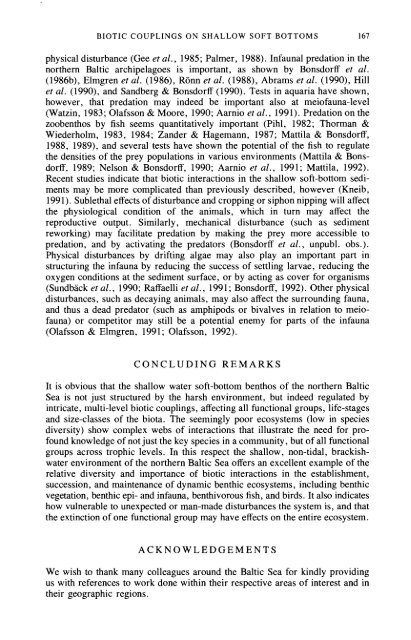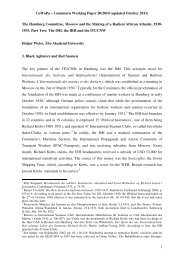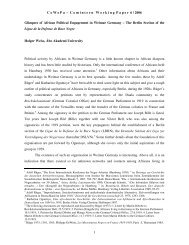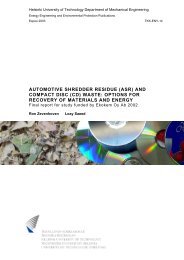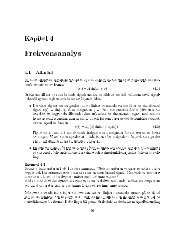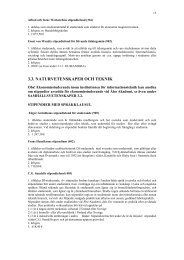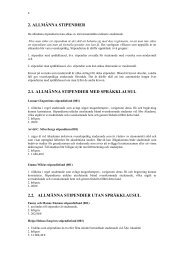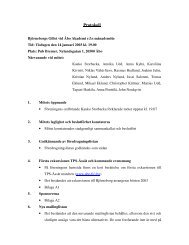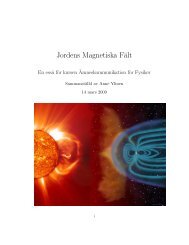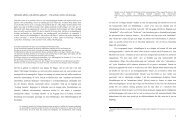biotic couplings on shallow water soft bottoms-examples from the ...
biotic couplings on shallow water soft bottoms-examples from the ...
biotic couplings on shallow water soft bottoms-examples from the ...
You also want an ePaper? Increase the reach of your titles
YUMPU automatically turns print PDFs into web optimized ePapers that Google loves.
BIOTIC COUPLINGS ON SHALLOW SOFT BOTTOMS 167<br />
physical disturbance (Gee et al., 1985; Palmer, 1988). Infaunal predati<strong>on</strong> in <strong>the</strong><br />
nor<strong>the</strong>rn Baltic archipelagoes is important, as shown by B<strong>on</strong>sdorff et al.<br />
(1986b), Elmgren et al. (1986), R<strong>on</strong>n et al. (1988), Abrams et al. (1990), Hill<br />
et al. (1990), and Sandberg & B<strong>on</strong>sdorff (1990). Tests in aquaria have shown,<br />
however, that predati<strong>on</strong> may indeed be important also at meiofauna-level<br />
(Watzin, 1983; Olafss<strong>on</strong> & Moore, 1990; Aarnio et al., 1991). Predati<strong>on</strong> <strong>on</strong> <strong>the</strong><br />
zoobenthos by fish seems quantitatively important (Pihl, 1982; Thorman &<br />
Wiederholm, 1983, 1984; Zander & Hagemann, 1987; Mattila & B<strong>on</strong>sdorff,<br />
1988, 1989), and several tests have shown <strong>the</strong> potential of <strong>the</strong> fish to regulate<br />
<strong>the</strong> densities of <strong>the</strong> prey populati<strong>on</strong>s in various envir<strong>on</strong>ments (Mattila & B<strong>on</strong>s-<br />
dorff, 1989; Nels<strong>on</strong> & B<strong>on</strong>sdorff, 1990; Aarnio et al., 1991; Mattila, 1992).<br />
Recent studies indicate that <str<strong>on</strong>g>biotic</str<strong>on</strong>g> interacti<strong>on</strong>s in <strong>the</strong> <strong>shallow</strong> <strong>soft</strong>-bottom sedi-<br />
ments may be more complicated than previously described, however (Kneib,<br />
1991). Sublethal effects of disturbance and cropping or siph<strong>on</strong> nipping will affect<br />
<strong>the</strong> physiological c<strong>on</strong>diti<strong>on</strong> of <strong>the</strong> animals, which in turn may affect <strong>the</strong><br />
reproductive output. Similarly, mechanical disturbance (such as sediment<br />
reworking) may facilitate predati<strong>on</strong> by making <strong>the</strong> prey more accessible to<br />
predati<strong>on</strong>, and by activating <strong>the</strong> predators (B<strong>on</strong>sdorff et al., unpubl. obs.).<br />
Physical disturbances by drifting algae may also play an important part in<br />
structuring <strong>the</strong> infauna by reducing <strong>the</strong> success of settling larvae, reducing <strong>the</strong><br />
oxygen c<strong>on</strong>diti<strong>on</strong>s at <strong>the</strong> sediment surface, or by acting as cover for organisms<br />
(Sundback et al., 1990; Raffaelli et al., 1991 ; B<strong>on</strong>sdorff, 1992). O<strong>the</strong>r physical<br />
disturbances, such as decaying animals, may also affect <strong>the</strong> surrounding fauna,<br />
and thus a dead predator (such as amphipods or bivalves in relati<strong>on</strong> to meio-<br />
fauna) or competitor may still be a potential enemy for parts of <strong>the</strong> infauna<br />
(Olafss<strong>on</strong> & Elmgren, 1991 ; Olafss<strong>on</strong>, 1992).<br />
CONCLUDING REMARKS<br />
It is obvious that <strong>the</strong> <strong>shallow</strong> <strong>water</strong> <strong>soft</strong>-bottom benthos of <strong>the</strong> nor<strong>the</strong>rn Baltic<br />
Sea is not just structured by <strong>the</strong> harsh envir<strong>on</strong>ment, but indeed regulated by<br />
intricate, multi-level <str<strong>on</strong>g>biotic</str<strong>on</strong>g> <str<strong>on</strong>g>couplings</str<strong>on</strong>g>, affecting all functi<strong>on</strong>al groups, life-stages<br />
and size-classes of <strong>the</strong> biota. The seemingly poor ecosystems (low in species<br />
diversity) show complex webs of interacti<strong>on</strong>s that illustrate <strong>the</strong> need for pro-<br />
found knowledge of not just <strong>the</strong> key species in a community, but of all functi<strong>on</strong>al<br />
groups across trophic levels. In this respect <strong>the</strong> <strong>shallow</strong>, n<strong>on</strong>-tidal, brackish-<br />
<strong>water</strong> envir<strong>on</strong>ment of <strong>the</strong> nor<strong>the</strong>rn Baltic Sea offers an excellent example of <strong>the</strong><br />
relative diversity and importance of <str<strong>on</strong>g>biotic</str<strong>on</strong>g> interacti<strong>on</strong>s in <strong>the</strong> establishment,<br />
successi<strong>on</strong>, and maintenance of dynamic benthic ecosystems, including benthic<br />
vegetati<strong>on</strong>, benthic epi- and infauna, benthivorous fish, and birds. It also indicates<br />
how vulnerable to unexpected or man-made disturbances <strong>the</strong> system is, and that<br />
<strong>the</strong> extincti<strong>on</strong> of <strong>on</strong>e functi<strong>on</strong>al group may have effects <strong>on</strong> <strong>the</strong> entire ecosystem.<br />
ACKNOWLEDGEMENTS<br />
We wish to thank many colleagues around <strong>the</strong> Baltic Sea for kindly providing<br />
us with references to work d<strong>on</strong>e within <strong>the</strong>ir respective areas of interest and in<br />
<strong>the</strong>ir geographic regi<strong>on</strong>s.


